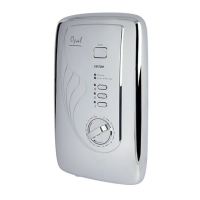Opal
5
parts of other appliances and services
in the room in which the shower is to
be installed, to conform to current IEE
regulations.
5.1
All exposed metallic parts in the bathroom
must be bonded together using a cable of
at least 4mm² cross sectional area. These
parts include metal baths, radiators, water
pipes, taps and waste fittings.
6
For close circuit protection DO NOT use
a rewireable fuse. Instead use a suitably
rated miniature circuit breaker (MCB) or
cartridge fuse (see table A).
6.1
In the interest of electrical safety a 30mA
residual current device (RCD) should be
installed in all UK electric and pumped
shower circuits. This may be part of the
consumer unit or a separate unit.
7
A 45 amp double pole isolating switch
with a minimum contact gap of 3mm in
both poles must be incorporated in the
circuit.
7.1
It must have a mechanical indicator
showing when the switch is in the
OFF position, and the wiring must be
connected to the switch without the use of
a plug or socket outlet.
7.2
The switch must be accessible and clearly
identifiable, but out of reach of a person
using a fixed bath or shower, except for
Twin and earth PVC insulated cable
CURRENT CARRYING CAPACITY
clipped direct or
installed in an in conduit buried in a non
insulated wall or trunking insulated wall
6mm² 6mm
²
6mm²
32A 38A 46A
10mm²
10mm²
10mm²
43A 52A 63A
16mm²
16mm²
16mm²
57A 69A 85A
Note: Cable selection is dependent
on derating factors
the cord of a cord operated switch, and
should be placed so that it is not possible
to touch the switch body while standing
in a bath or shower cubicle. It should be
readily accessible to switch off after using
the shower.
8
Where shower cubicles are located in any
rooms other than bathrooms, all socket
outlets in those rooms must be protected
by a 30mA RCD.
9
The current carrying capacity of the cable
must be at least that of the shower circuit
protection (see table B).
9.1
To obtain full advantage of the power
provided by the shower, use the shortest
cable route possible from the consumer
unit to the shower.
9.2
It is also necessary to satisfy the
disconnection time and thermal
constraints which means that for any given
combination of current demand, voltage
drop and cable size, there is a maximum
permissible circuit length.
10
The shower circuit should be separated
from other circuits by at least twice the
diameter of the cable or conduit.
10.1 The current rating will be reduced if the
cabling is bunched with others, surrounded
by thermal loft or wall insulation or placed
in areas where the ambient temperature
is above 30°C. Under these conditions,
derating factors apply and it is necessary to
select a larger cable size.
10.2
In the majority of installations, the
cable will unavoidably be placed in one
or more of the above conditions. This
being so, it is strongly recommended
to use a minimum of 10mm cabling
throughout the shower installation.
10.3
In any event, it is essential that individual
site conditions are assessed by a competent
electrician in order to determine the
correct cable size and permissible circuit
length.
Table B

